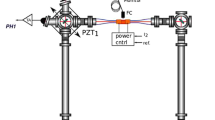Abstract
We report the observation of the ground rotation induced by the M w = 9.0, 11th of March 2011, Japan earthquake. The rotation measurements have been conducted with a ring laser gyroscope operating in a vertical plane, thus detecting rotations around the horizontal axis. Comparison of ground rotations with vertical accelerations from a co-located force balance accelerometer shows excellent ring laser coupling at periods longer than 100 s. Under the plane wave assumption, we derive a theoretical relationship between horizontal rotation and vertical acceleration for Rayleigh waves. Due to the oblique mounting of the gyroscope with respect to the wave direction of arrival, apparent velocities derived from the acceleration/rotation rate ratio are expected to be always larger than or equal to the true wave propagation velocity. This hypothesis is confirmed through comparison with fundamental mode, Rayleigh-wave phase velocities predicted for a standard Earth model.







Similar content being viewed by others
Notes
An other ring laser operating with the vertical plane is the PR-1 ring laser. It is mounted on the wall of a laboratory in Department of Physics and Astronomy building at University of Christchurch. However, its major goal is the detection of seismically induced rotations in buildings, and it is not operating continuously.
References
Belfi J, Beverini N, Bosi F, Carelli G, Di Virgilio A, Kolker D, Maccioni E, Ortolan A, Passaquieti R, Stefani F (2012) Performance of “G-Pisa” ring laser gyro at the Virgo site. J Seismol. doi:10.1007/s10950-012-9277-8
Cochard A, Igel H, Schuberth B, Suryanto W, Velikoseltsev A, Schreiber U, Wassermann J, Scherbaum F, Vollmer D (2006) Rotational motions in seismology: theory, observation, simulation. In: Teisseyre R, Takeo M, Majewski E (eds) Earthquake source asymmetry, structural media and rotation effects. Springer, Berlin, pp 7, 62, 72
Igel H, Schreiber KU, Flaws A, Schuberth B, Velikoseltsev A, Cochard A (2005) Rotational motions induced by the M8. 1 Tokachi-oki earthquake, September 25, 2003. Geophys Res Lett 32(8):L08309
Igel H, Cochard A, Wassermann J, Asher Flaws F, Schreiber U, Velikoseltsev A Pham Dinh N (2007) Broad-band observations of earthquake-induced rotational ground motions. Geophys J Int 168:182–196
Kennett BLN, Engdahl ER, Buland R (1995) Constraints on seismic velocities in the Earth from traveltimes. Geophys J Int 122:108–124
Kurrle D, Igel H, Ferreira AMG, Wassermann J, Schreiber U (2010) Can we estimate local Love wave dispersion properties from collocated amplitude measurements of translations and rotations? Geophys Res Lett 37:L04307
Lay T and Wallace TC (1995) Modern global seismology. Academic, San Diego
Li H, Sun L, Wang S (2001) Improved approach for obtaining rotational components of seismic motion. Transactions, SMiRT16, Washington, DC
McLeod DP, Stedman GE, Webb TH, Schreiber KU (1998) Comparison of standard and ring laser rotational seismograms. BSSA 88(6):1495–1503
Pancha A, Webb TH, Stedman GE, McLeod DP, Schreiber KU (2000) Ring laser detection of rotations from teleseismic waves. Geophys Res Lett 27:3553–3556
Rautenberg V, Plag HP, Burns M, Stedman GE, Juttner HU (1997) Tidally induced Sagnac signal in a ring laser. Geophys Res Lett 24(8):893–896
Schreiber KU, Klugel T, Stedman GE (2003) Earth tide and tilt detection by a ring laser gyroscope. J Geophys Res 108:2132
Schreiber KU, Stedman GE, Igel H, Flaws A (2006) Ring laser gyroscopes as rotation sensors for seismic wave studies. In: Teisseyre R et al (eds) Earthquake source asymmetry, structural media and rotation effects. Springer, Berlin, pp 377–390
Stedman GE (1997) Ring-laser tests of fundamental physics and geophysics. Rep Prog Phys 60–6:615
Stedman GE, Li Z, Bilger HR (1995) Sideband analysis and seismic detection in large ring laser. Appl Opt 34:7390–7396
Takeo M (2009) Rotational motions observed during an earthquake swarm in April 1998 offshore Ito, Japan. Bull Seism Soc Am 99(2B):1028
Acknowledgements
We acknowledge F. Bosi, A. Gebauer, R. Hurst, and U. Schreiber for the useful discussions. A. Velikoseltsev acknowledges the partial support from the Federal Targeted Program Scientific and scientific pedagogical personnel of the innovative Russia in 2009–2013 of the Ministry of Education and Science of the Russian Federation.
Author information
Authors and Affiliations
Corresponding author
Rights and permissions
About this article
Cite this article
Belfi, J., Beverini, N., Carelli, G. et al. Horizontal rotation signals detected by “G-Pisa” ring laser for the M w = 9.0, March 2011, Japan earthquake. J Seismol 16, 767–776 (2012). https://doi.org/10.1007/s10950-012-9276-9
Received:
Accepted:
Published:
Issue Date:
DOI: https://doi.org/10.1007/s10950-012-9276-9




